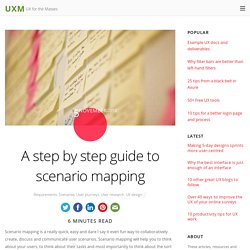

Story Mapping and/vs Process Maps. One of the key philosophies of Agile software development is to have information radiators visible on the wall so that the progress of the team as well as what team currently is working on gets clearly visible to anybody who visits to the team area.

That includes stakeholders, project managers, team or anybody from the organisation. However, haven’t you observed that many times, as you look at the card-wall (Scrum Board), things are not very clear to you. Card wall may look like the mesh of user-stories with statuses in To Do, In Progress or Done. However some of the bigger questions are not clearly answered by just looking at user-stories. For instance: What part of business process, team is working on in the current iteration?
How about having a pictorial view of whole business flow as a process-map, identifying the user-stories (work to be done) in it? If you take a closer look, you will find that some of the user-stories like story 2 are common to multiple business flows. Hello there! Multi-tier Kanban » Tools For Agile Blog. Multi-tier Kanban Posted on January 14th, 2011 in Kanban, Lean by siddharta || 5 Comments [Fabrice has kindly translated this post into French - Kanban multi-niveaux] One of the challenges with enterprise kanban is to link stakeholder needs with development team needs.
Stakeholders think in terms of large pieces of functionality (Lets call them Epics), whereas the development team requires small fine grained stories.Stakeholders are interested in the end to end lead time of the epic, whereas the team kanban board only measures the lead time of a single story The solution to this is multi-tier kanban.
User Story Maps User story mapping is a visual mapping technique to generate a shared understanding of a product or initiative. We start with the Epic that stakeholders are interested in. Enterprise Kanban Board Next, we create an enterprise Kanban board. The diagram shows the process in action. Webinar on Leveraging Enterprise Kanban. The new user story backlog is a map. Why the flat user story backlog doesn’t work, and how to build a better backlog that will help you more effectively explain your system, prioritize, and plan your releases.

This is Gary. Gary and I worked together for a day to build a user story map - a better version of a product backlog. Building a user story map helps us focus on the big picture - the product as a whole instead of getting myopically focused on an individual story. When it comes time to prioritize, Gary did so with the entire context of the system in view. In Gary's case he originally set out to build Mimi - short for Music Industry Marketing Interface. Mimi shipped after a lot of sweat and effort from Gary, Dave Hoover, and the fine folks at Obtiva. Flat backlogs don't work for me One of the more troubling things, for me, about common Agile development practice is the idea of the flat user story backlog.
I'm writing this from the plane as I fly back from a client site. "We spend lots of time working with our customers. Www.agileproductdesign.com/downloads/user_story_mapping_quickref_comic.pdf. A step by step guide to scenario mapping. 6 minutes read Scenario mapping is a really quick, easy and dare I say it even fun way to collaboratively create, discuss and communicate user scenarios.

Scenario mapping will help you to think about your users, to think about their tasks and most importantly to think about the sort of user experience you want to provide. It will also help to ensure that your designs are grounded in the real world because scenario mapping forces you to consider the context in which a design is likely to be used. In this article I walk you though step by step how to go about creating scenario maps and why they’re so damn useful in the first place.
What’s a scenario? Before we start looking at scenario mapping I thought it would be useful to very quickly define what I mean by scenarios. Scenarios are typically used to provide a picture of the intended user experience (i.e. what ideally should happen), but can equally outline what currently happens.
What’s scenario mapping? 1.